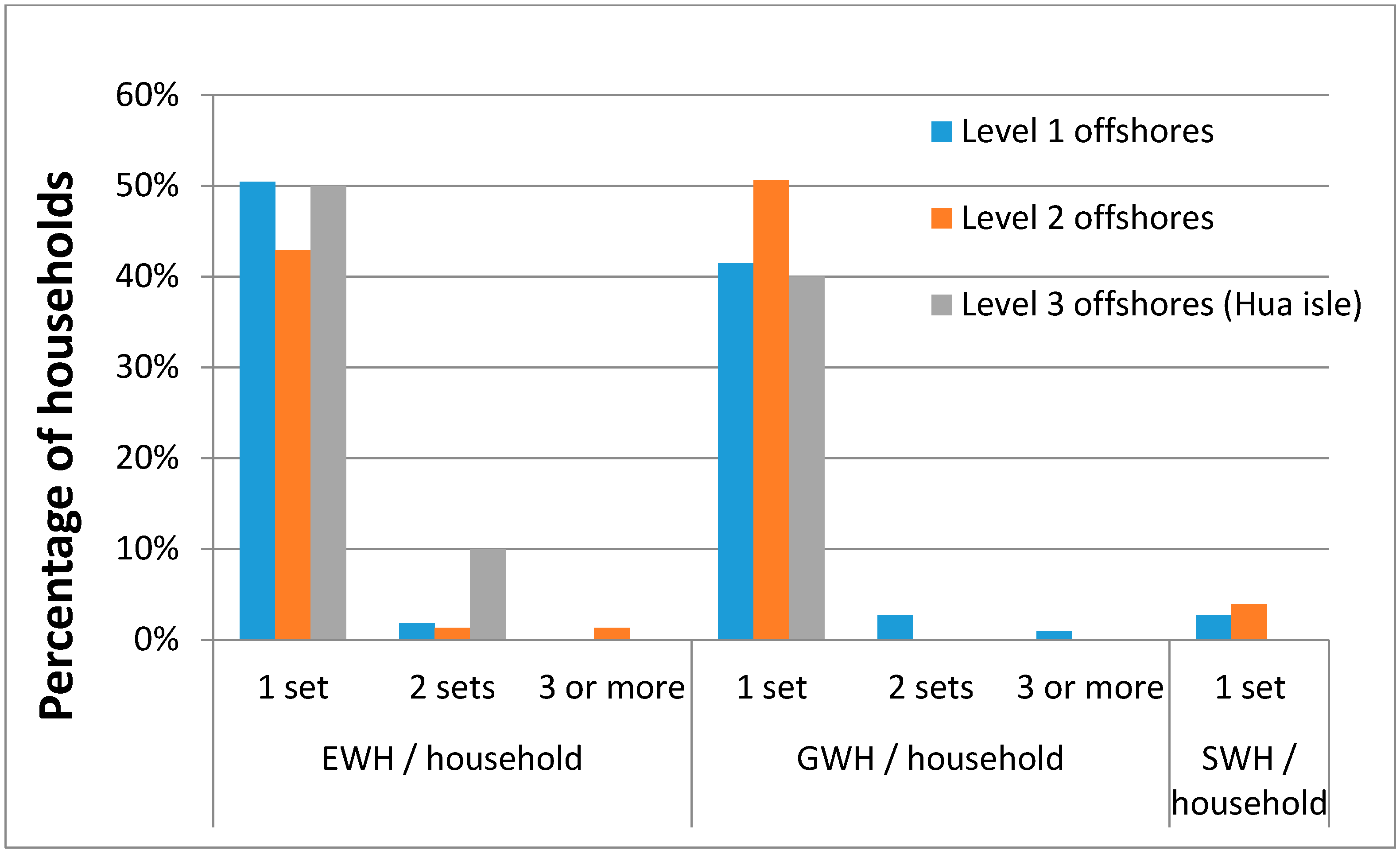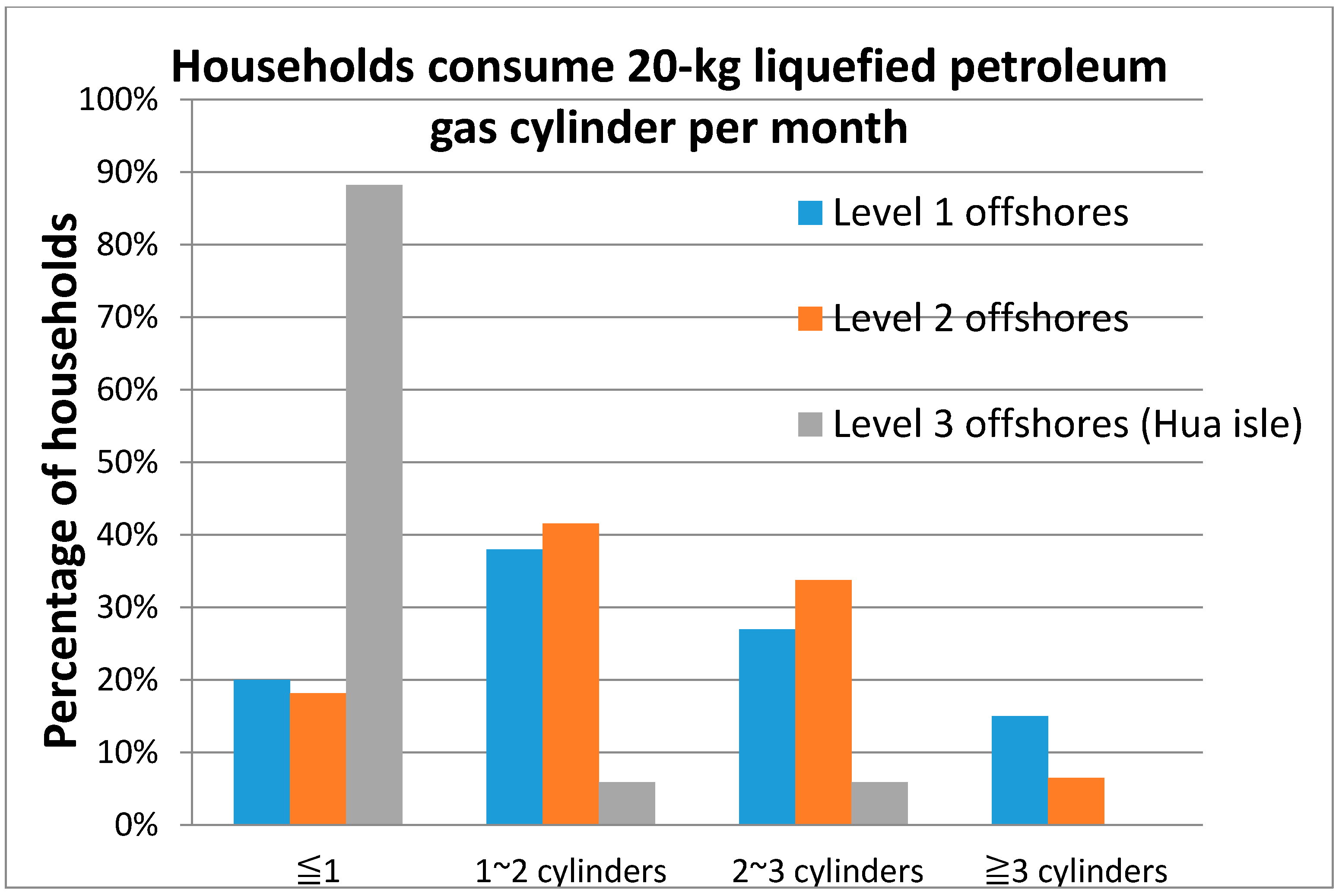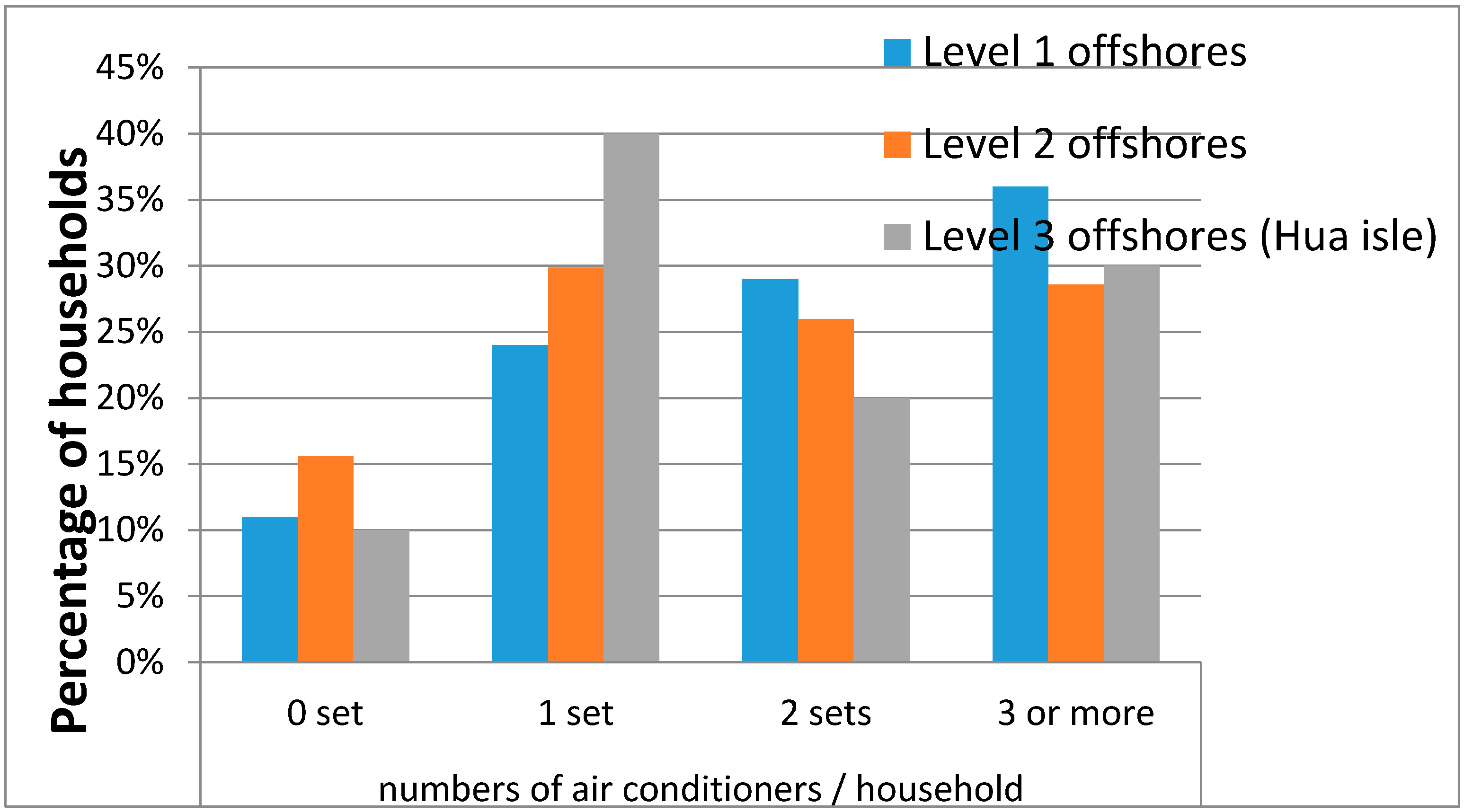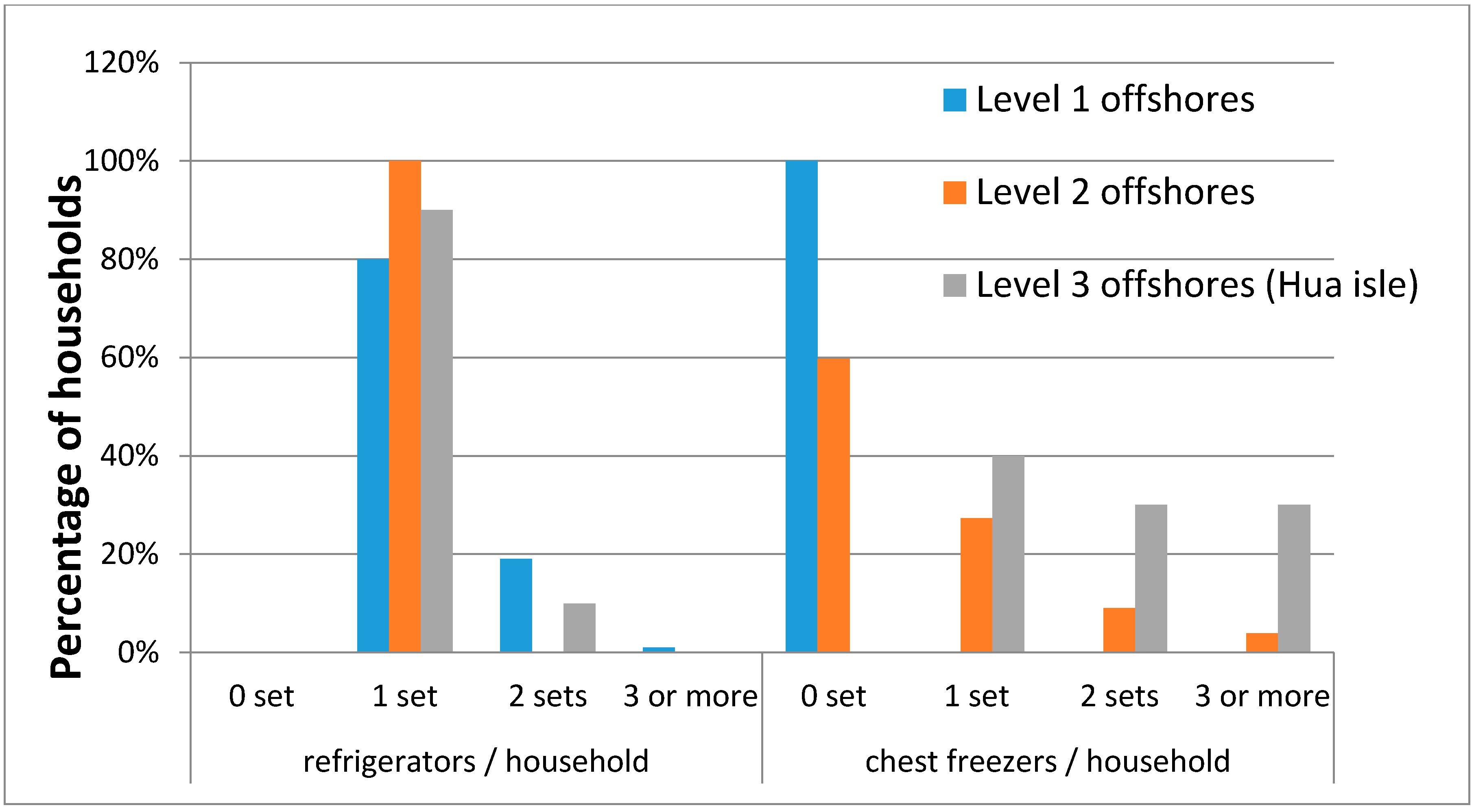Energy Usage of Residents on Offshore Islands in Taiwan
Abstract
:1. Introduction
| Classification of isle | Isle |
|---|---|
| Level 1 offshore isles | Magong City, Husi Township, Siyu Township, and Baisha Township |
| Level 2 offshore isles | Hoojing Isle, Tongpan Isle, Yuanbei Isle, Dacang Isle, Jibei Isle, Niao Isle, Cimei Isle, and Wangan Isle |
| Level 3 offshore isles | Siyu-ping Isle, Dongyu-ping Isle, Shiji Isle, Dongji Isle, and Hua Isle |
2. Survey Method
| Isle | Minimum number of samples | Expected number of households for survey | Actual number of households for survey |
|---|---|---|---|
| Level 1 | 89 households | 100 households | 100 households |
| Level 2 | 84 households | 84 households | 77 households |
| Level 3 | 30 households | 30 households | 17 households |
3. Survey Results at Each Level of Offshore Isle in Penghu County
3.1. Electricity Pricing and Liquefied Petroleum Gas (LPG) Cost
3.2. Water Heaters and LPG Usage


3.3. Air Conditioner Use and Duration of Operation


3.4. Refrigerator and Freezer Usage

| Level of isle | People/household | Air conditioners/household | Refrigerators/households | Freezers/household | Electricity pricing/month (NT$/m) | LPG cylinders used/household/month | LPG cost (20-kg cylinder) |
|---|---|---|---|---|---|---|---|
| 1 | 3.8 | 2.1 | 1.3 | 0.0 | 1519 | 2.0 | 914.5 |
| 2 | 3.5 | 2.0 | 1.0 | 1.6 | 1359 | 1.9 | 954.9 |
| 3 | 2.5 | 2.5 | 1.0 | 2.0 | 300 | 0.4 | 1000 |
4. Household Appliance Usage in Mainland Taiwan and Offshore Isles
4.1. Household Appliances
| Appliances | One set, % | ≥ 2 sets, % | ||||||
|---|---|---|---|---|---|---|---|---|
| Taiwan | Level 1 | Level 2 | Level 3 | Taiwan | Level 1 | Level 2 | Level 3 | |
| Electric fan | 15.2 | 14.0 | 1.2 | 0.0 | 80.2 | 86.0 | 88.3 | 100.0 |
| p = 0.158 | p = 0.099 | |||||||
| Air conditioner | 20.4 | 24.0 | 29.8 | 30.0 | 64.8 | 65.0 | 54.5 | 50.0 |
| p = 0.202 | p = 0.065 | |||||||
| Television | 38.6 | 50.0 | 48.1 | 40.0 | 59.8 | 47.0 | 50.6 | 50.0 |
| p = 0.213 | p = 0.065 | |||||||
| Rice cooker | 60.2 | 84.0 | 70.1 | 80.0 | 33.7 | 12.0 | 27.3 | 20.0 |
| p = 0.165 | p = 0.078 | |||||||
| Computer | 45.3 | 58.0 | 16.9 | 20.0 | 24.9 | 11.0 | 6.5 | 0.0 |
| p = 0.039 | p = 0.065 | |||||||
| Refrigerator * | 76.7 | 78.0 | 31.2 | 50.0 | 20.7 | 20.0 | 66.3 | 50.0 |
| p = 0.014 | p = 0.041 | |||||||
| Water dispenser | 53.9 | 68.0 | 66.2 | 70.0 | 4.5 | 3.0 | 1.3 | 0.0 |
| p = 0.125 | p = 0.111 | |||||||
| Electric thermo pot | 39.8 | 44.0 | 24.7 | 40.0 | 3.7 | 1.0 | 2.6 | 0.0 |
| p = 0.098 | p = 0.113 | |||||||
| Washing machine * | 87.2 | 92.0 | 87.1 | 70.0 | 6.1 | 2.0 | 3.9 | 0.0 |
| p = 0.000 | p = 0.105 | |||||||
| Electric heater * | 17.1 | 19.0 | 14.3 | 10.0 | 4.6 | 0.0 | 3.9 | 20.0 |
| p = 0.005 | p = 0.205 | |||||||
| Electric water heater * | 26.3 | 56.0 | 42.9 | 40.0 | 2.2 | 2.0 | 2.6 | 0.0 |
| p = 0.045 | p = 0.061 | |||||||
| Electric oven * | 44.1 | 19.0 | 14.3 | 10.0 | 1.6 | 0.0 | 3.9 | 20.0 |
| p = 0.047 | p = 0.261 | |||||||
| Microwave oven * | 50.4 | 36.0 | 27.3 | 20.0 | 0.9 | 1.0 | 0.0 | 0.0 |
| p = 0.014 | p = 0.183 | |||||||
| Freezer * | -- | 0.0 | 27.3 | 40.0 | -- | 0.0 | 14.0 | 60.0 |
| p = 0.023 | p = 0.025 | |||||||
4.2. Energy Usage
| Duration of air conditioner usage | Usage Percentage (%) | |||
|---|---|---|---|---|
| Taiwan | Level 1 | Level 2 | Level 3 | |
| < 3 h (p = 0.065) | 11.4 | 33.0 | 36.4 | 20.0 |
| 3−6 h (p = 0.072) | 27.5 | 28.0 | 28.6 | 40.0 |
| 6−9 h (p = 0.072) | 24.0 | 33.0 | 23.4 | 0 |
| > 9 h (p = 0.023) | 37.1 | 6.0 | 11.7 | 40.0 |
5. Conclusions
Acknowledgments
Author Contributions
Conflicts of Interest
References
- Shrestha, G.; Traina, S.J.; Swanston, C.W. Black carbon’s properties and role in the environment: A comprehensive review. Sustainability 2010, 2, 294–320. [Google Scholar]
- Lau, L.C.; Lee, K.T.; Mohamed, A.R. Global warming mitigation and renewable energy policy development from the Kyoto Protocol to the Copenhagen Accord—A comment. Renew. Sustain. Energy Rev. 2012, 16, 5280–5284. [Google Scholar] [CrossRef]
- Sisbot, S.; Yildiran, U.; Tunc, M. Optimal distribution of electrical energy sources in Turkey with the impact of the Kyoto Protocol. Energy Sourc. Part B 2015, 10, 288–297. [Google Scholar] [CrossRef]
- Bureau of Energy, Ministry of Economic Affairs (BEMOEA). 2012 Energy Statistical Data Book; BEMOEA: Taipei, Taiwan, 2013.
- Wu, J.H.; Huang, Y.H. Renewable energy perspectives and supporting mechanisms in Taiwan. Renew. Energy 2006, 31, 1718–1732. [Google Scholar] [CrossRef]
- Chen, F.L.; Lu, S.M.; Wang, C.C.; Chang, Y.L. Promotion strategies for renewable energy in Taiwan. Renew. Sustain. Energy Rev. 2008, 12, 1681–1691. [Google Scholar] [CrossRef]
- Chang, K.C.; Lin, W.M.; Lee, T.S.; Chung, K.M. Subsidy programs on diffusion of solar water heaters: Taiwan’s experience. Energy Policy 2011, 39, 563–567. [Google Scholar] [CrossRef]
- Chang, C.C.; Wang, C.M. Energy source options for the generation of electrical power in Taiwan. Energy Conv. Manag. 2014, 88, 582–588. [Google Scholar] [CrossRef]
- Lin, W.M.; Chang, K.C.; Chung, K.M. Payback period for residential solar water heaters in Taiwan. Renew. Sustain. Energy Rev. 2015, 41, 901–906. [Google Scholar] [CrossRef]
- Chang, K.C.; Lin, W.M.; Chung, K.M. Sustainable development for solar heating systems in Taiwan. Sustainability 2015, 7, 1970–1984. [Google Scholar] [CrossRef]
- Directorate General of Budget Accounting and Statistics (DGBAS). Key economic and social indicators. Available online: http://www.dgbas.gov.tw (accessed on 17 March 2015).
- Barnes, D.F. Effective solutions for rural electrification in developing countries: Lessons from successful programs. Curr. Opin. Environ. Sustain. 2011, 3, 260–264. [Google Scholar] [CrossRef]
- Bhattacharyya, S.C. Financing energy access and off-grid electrification: A review of status, options and challenges. Renew. Sustain. Energy Rev. 2013, 20, 462–472. [Google Scholar] [CrossRef]
- Dornan, M. Access to electricity in small island developing states of the Pacific: Issues and challenges. Renew. Sustain. Energy Rev. 2014, 31, 726–735. [Google Scholar] [CrossRef]
- Monroy, C.R.; Hernandez, A.S.S. Main issues concerning the financing and sustainability of electrification projects in rural areas: International survey results. Energy Sustain. Dev. 2005, 9, 17–25. [Google Scholar] [CrossRef]
- Javadi, F.S.; Rismanchi, B.; Sarraf, M.; Afshar, O.; Saidur, R.; Ping, H.W.; Rahim, N.A. Global policy of rural electrification. Renew. Sustain. Energy Rev. 2013, 19, 402–416. [Google Scholar] [CrossRef]
- Cannon, J.C. Issues in sampling and sample design a managerial perspective. In Travel, Tourism and Hospitality Research: A Handbook for Managers, 2nd ed.; Ritchie, J.R.B., Oeldner, C.R., Eds.; John Wiley & Sons: New York, NY, USA, 1994; pp. 131–143. [Google Scholar]
© 2015 by the authors; licensee MDPI, Basel, Switzerland. This article is an open access article distributed under the terms and conditions of the Creative Commons Attribution license (http://creativecommons.org/licenses/by/4.0/).
Share and Cite
Lu, S.-C.; Chang, K.-C.; Lin, W.-M.; Chung, K.-M. Energy Usage of Residents on Offshore Islands in Taiwan. Sustainability 2015, 7, 6652-6664. https://doi.org/10.3390/su7066652
Lu S-C, Chang K-C, Lin W-M, Chung K-M. Energy Usage of Residents on Offshore Islands in Taiwan. Sustainability. 2015; 7(6):6652-6664. https://doi.org/10.3390/su7066652
Chicago/Turabian StyleLu, Szu-Cheng, Keh-Chin Chang, Wei-Min Lin, and Kung-Ming Chung. 2015. "Energy Usage of Residents on Offshore Islands in Taiwan" Sustainability 7, no. 6: 6652-6664. https://doi.org/10.3390/su7066652







